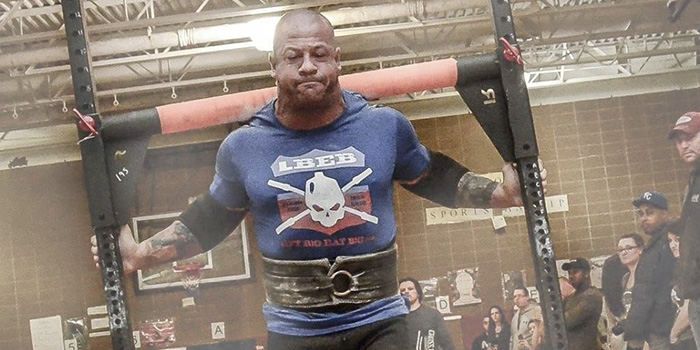
In strongman, many competitions are won and lost from conditioning. The order of the events varies from show to show, where I have ended with stones or another time with a “death medley.” A death medley in strongman can be anything from carries, loading, and dragging combined in any way. They are completely exhausting and usually leave you lying on the floor, gasping for air until you can recover.
From my experience, almost every show has a medley like these. You need to have good conditioning, and here’s a huge part, you need to be able to run fast! Not just with weight in your hands, but you have to be able to sprint back to the next implement. Competitors lose a lot of time running out of gas while sprinting back. This is truer for the heavyweights, but even the big boys need to move fast to not lose vital points. We’ve seen countless times when a competitor who can press, deadlift, and yoke but completely lose it on a death medley.
RECENT: 5 Upper Back Basics to Build Strength and Size
When I first started my strongman career, I was decent at the static events coming from a powerlifting background, but I was very fast because I loved sprinting and plyometrics at the time. Moving events came naturally to me, and I was able to win events because I was one of the few competitors that enjoyed sprinting back and forth for implements. Along the way, injuries added up from years of competing, and I also moved up a weight class into the heavyweights. My static strength increased dramatically, but I got slow in the process. I had to look back at my training when I was at my fastest to see where I had gotten lazy.
Of course, increased mass will slow anyone down, but I slacked off on the little things as I got bigger. Box jumps were always a big part of my training, as well as sprinting. Both went to the back burner as I focused more on bodybuilding, which there is nothing wrong with, but I needed to keep my speed up at the same time.
I’m a big believer in that you can maintain your speed as you increase size if you keep up with the proper training. Like I said, I stopped doing sprints and box jumps in place of static strength. I did work on my weak points over that time, which were my conventional deadlift and my press. Both events are now strengths for me, which was the goal. The competitors who consistently win in strongman are the ones that not necessarily dominate just one event; they do well across the board with no weak points at any events.
Programming for a death medley event can be tricky. Many people make the mistake of going too heavy right away with maybe one top set. They grind away, hobble, and barely finish while enforcing poor technique. Training this way will make you slow in the long run. You might be able to finish the medley, but you won’t be the fastest. I would compare this to maxing out each week and not doing any rep or speed work. It’s a recipe for disaster.
Let’s take an example of a medley for someone’s upcoming competition. They are a heavyweight that has a 300-pound sandbag, 300-pound keg, 400-pound duck walk, and a 400-pound sled drag (I had this at a competition one time; it’s the epitome of a death medley). Now, the competitor might be able to get right into this and barely finish. However, a better way of getting into this is to start out much lighter while going for a longer distance for multiple sets.
You need to build your training economy first; to put it simply, it’s getting your lazy ass in shape to move. Most competitions are 50 feet, so we are going to start this at 75 feet for everything. An example of a program would look like this:
- Week 1: 200/200/275/300 4 sets of 75 feet. This should not be heavy, but you should be moving fast with each implement, and by the last set, laying on the floor gasping for air.
- Week 2: 220/220/300/325 3 sets of 75 feet. More weight but one less set with the same distance. You should feel a big improvement over last week.
- Week 3: 240/240/340/350 3 sets of 70 feet. Increased weight but slightly shorter distance.
- Week 4: 260/260/350/370 2 sets of 70 feet. Weight is starting to creep up, so we go down to 2 sets. Still moving a good distance.
- Week 5: 220/220/300/325 4 sets of 60 feet. Same weight as Week 2, but we do 4 sets this time at a lesser distance. At this point, moving with the implements should be much more manageable.
- Week 6: 280/280/370/390 2 sets of 60 feet. Weight is getting up there, but with all the work we have done, this should be no problem for 2 sets.
- Week 7: Competition weight 2 sets of 50 feet. It may not be easy at this point, but you are ready to move the weight, and with speed.
- Week 8: 320/320/410/410 1 set of 50 feet. Work up to 1 set just over competition weight. This should be very tough but manageable.
- Week 9: 200/200/275/300 2 sets of 60 feet. This would be the week before the competition. Light run through the medley.
RELATED: 12-Week Strong(wo)man Program for the Off-Season
Come competition time, you should be conditioned to running and carrying heavy implements, as well as be able to move quickly.
Accessory lifts are something that is more important than most think for moving events. Also, these accessory lifts not only apply to medleys as mentioned above but also farmers walk and yoke events.
First up is a movement that I see most competitors avoid, especially in the heavyweight class. The bigger you are, the harder it is to balance on one leg, and even more of a reason why you should be training on one leg. Personally, there are a lot of single leg movements that bother my knees.
For a lot of you who have been competing for a long time, I’m sure you experience the same thing. Walking with a heavy yoke on your back for years will take a toll on your joints. I generally shy away from walking lunges for this reason, so if any of you fall into the same boat, give these single leg variations a try instead.
Single Leg Loop Squat or Bulgarian Split Squat
I prefer the loop squat, as it requires more balance and a lot more glute activations. Also, being able to move my back leg takes the stress off my knee. I like to do these with a kettlebell held in the goblet position as shown.
In case you don’t feel comfortable being suspended on one leg, then try the Bulgarian Split Squat with your foot on the one leg squat attachment. Doing it this way allows for easier balance, and if you have to, you can hold onto something in front of you until you are comfortable to go hands-free and hold weight.
Suspension Strap Pistol Squat
I’m guessing most of you reading this cannot do a free-standing pistol squat; I know I sure as hell I can’t. While using a suspension strap, you can work as hard as you want to through the movement. These also allow you to get very low in the squat position, which is something I have trouble doing normally. Make sure you sit back like you can see in the video to take the stress off the knee. Only use the straps if you need to. I like to use them more at the bottom and less as I come up.
Plyometrics
Plyometrics are something that I simply got very lazy on doing as I got bigger. When I realized my moving events had slowed down, I had to look back at what I was doing at my fastest. This is another reason why you should be writing down all of your training so you can go back and see what worked and what didn’t.
Box jumps are my favorite explosive movements, and I feel they have the most benefit as well as being joint friendly when done correctly. I would recommend using the right kind of box jump, like the elitefts plyobox. Years ago, I would use only metal and wood plyoboxes, where if you missed, you should shred your shin on the edge of the box. Also, for those of you who train people, this is not a good thing to send your athletes home with. I have even seen people get stitches from ripping their shin open on the edge of a box.
To perform the box jump correctly, start with a moderate jumping height. There is absolutely no reason to go for max height when you try to lift your knees up to your head to land in this awkward position. You can jump as high as you can and still get the training effect not going for max height without the risk of missing and falling off the box. The key here is to absorb the landing. I try not to make a sound when I land, which is, again, easier on the joints.
Next, you want to step down off of the box. I know if you are doing these for time or in a competition, it is much faster to jump off, then jump back up, but there is a very high risk of tearing your Achilles tendon.
When I competed in CrossFit, it was something we had to do for speed. However, for what we are training for it’s not necessary, so step down and explode up. I generally keep the reps low as we are training to be explosive, and not to use it as conditioning, so three sets of three to five reps are all you need.
I also have to add that I like to do box jumps toward the end of my workout, which is the opposite of what most recommend. Starting out with an explosive movement can be painful on my knees until I get the blood flowing. After squatting, running the medley, and single leg work, my joints feel great for box jumps. This is just my personal experience, but if you have the same issues, then give this a shot.










